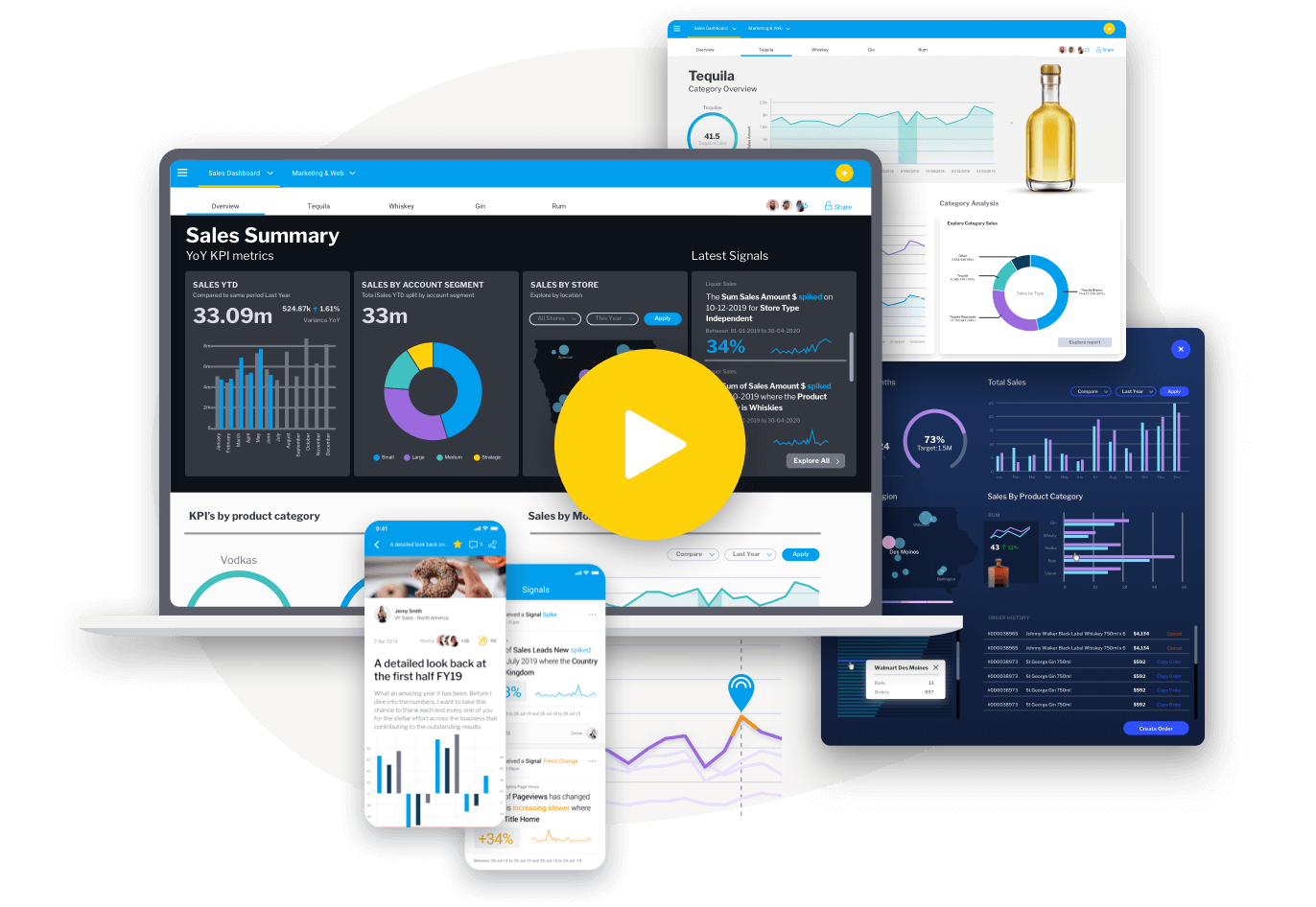
What is the Augmented Consumer? Understanding Users of AI Analytics
The rise of AI-powered features in today’s analytics solutions has increasingly displaced our reliance on dashboards by making it easier for business people to analyze their data.
With this rising paradigm shift, a new label has emerged: The augmented consumer.
On a surface-level, the word ‘augmented’ may conjure up a variety of different interpretations. AI-based dashboard assistants? Natural language-led reporting?
But what the term represents most of all is a pivotal change in thinking in the analytics space that aims to empower information consumers of all knowledge and skill levels to:
 People that only use dashboards either end up not using analytics to its fullest advantage, spend far too much time to find answers, have to involve an analyst intermediary to help them extract insights, or make incorrect conclusions and potentially flawed decisions.
However, new augmented user experiences within BI and analytics platforms have streamlined how business people can find out which insights are the most important to them and actionable using tools like machine-assisted insights and automated alerting.
These tools don’t replace the dashboard, but instead act as powerful extensions of it, making it easier (and faster) to explore and understand what their data says.
In short, regular information consumers are fast becoming augmented consumers thanks to the proliferation of augmented analytics technologies into our everyday business intelligence tools, which are easier and more intuitive to use than ever.
People that only use dashboards either end up not using analytics to its fullest advantage, spend far too much time to find answers, have to involve an analyst intermediary to help them extract insights, or make incorrect conclusions and potentially flawed decisions.
However, new augmented user experiences within BI and analytics platforms have streamlined how business people can find out which insights are the most important to them and actionable using tools like machine-assisted insights and automated alerting.
These tools don’t replace the dashboard, but instead act as powerful extensions of it, making it easier (and faster) to explore and understand what their data says.
In short, regular information consumers are fast becoming augmented consumers thanks to the proliferation of augmented analytics technologies into our everyday business intelligence tools, which are easier and more intuitive to use than ever.
 Contextual analytics: Contextualized insights delivered to business users right at the point in time they consume data and need to take action, without needing to get an analyst to help them or switch application contexts to find more information, as it integrates analytics in a way that makes it a seamless part of the product experience.
Data storytelling: The ability to create and share data stories in the same analytics platform that lessens the need for users to have to start in a predefined dashboard and then explore further (both manually and in an augmented way) for insights. These stories help explain the context behind the numbers and highlight the most meaningful changes in the business to them in an engaging way - Yellowfin Stories is one such example.
Contextual analytics: Contextualized insights delivered to business users right at the point in time they consume data and need to take action, without needing to get an analyst to help them or switch application contexts to find more information, as it integrates analytics in a way that makes it a seamless part of the product experience.
Data storytelling: The ability to create and share data stories in the same analytics platform that lessens the need for users to have to start in a predefined dashboard and then explore further (both manually and in an augmented way) for insights. These stories help explain the context behind the numbers and highlight the most meaningful changes in the business to them in an engaging way - Yellowfin Stories is one such example.
- Use powerful analytics capabilities previously only available to analysts or specialists
- Deliver tailored, dynamic and personalized insights directly to the user automatically
- Take more efficient and effective data-led action within their core workflows
What does an augmented consumer mean?
The augmented consumer refers to any business person who leverages automated, contextual, AI-powered analytics capabilities as part of their data analysis workflow. What makes the augmented consumer different from typical analytics users is they don't rely on traditional dashboards as their main or only way to analyze their data. Predefined dashboards and reports have historically been considered by businesses as the primary method for analytics users to monitor, explore and analyze their data. Instead, users now have easier access to sophisticated features like automated business monitoring (ABM) and natural language query (NLQ) when exploring their data. These tools, as well as others powered by artificial intelligence and machine learning, come under the umbrella of augmented analytics, an industry term first coined by advisory firms in the late 2010s. Among regular analytics users themselves, the most popular term used to describe these powerful tools is AI analytics.Why the augmented consumer is important
Providing only dashboards to a user and expecting them to know exactly how to surface an insight, or precisely understand what the data is telling them when there’s so much on display is not enough to guarantee they will gain value or use your provided BI solution. This is due to limitations of traditional dashboards that lack AI analytics capability:- Users have to manually explore through dashboard data to surface what happened
- Users have to determine what action to take without guidance on if it’s correct
- Users may lack a certain level of knowledge of analytics to go beyond surface-level
 People that only use dashboards either end up not using analytics to its fullest advantage, spend far too much time to find answers, have to involve an analyst intermediary to help them extract insights, or make incorrect conclusions and potentially flawed decisions.
However, new augmented user experiences within BI and analytics platforms have streamlined how business people can find out which insights are the most important to them and actionable using tools like machine-assisted insights and automated alerting.
These tools don’t replace the dashboard, but instead act as powerful extensions of it, making it easier (and faster) to explore and understand what their data says.
In short, regular information consumers are fast becoming augmented consumers thanks to the proliferation of augmented analytics technologies into our everyday business intelligence tools, which are easier and more intuitive to use than ever.
People that only use dashboards either end up not using analytics to its fullest advantage, spend far too much time to find answers, have to involve an analyst intermediary to help them extract insights, or make incorrect conclusions and potentially flawed decisions.
However, new augmented user experiences within BI and analytics platforms have streamlined how business people can find out which insights are the most important to them and actionable using tools like machine-assisted insights and automated alerting.
These tools don’t replace the dashboard, but instead act as powerful extensions of it, making it easier (and faster) to explore and understand what their data says.
In short, regular information consumers are fast becoming augmented consumers thanks to the proliferation of augmented analytics technologies into our everyday business intelligence tools, which are easier and more intuitive to use than ever.
What capabilities do augmented consumers use?
Augmented analytics: AI and machine learning, conversational interfaces and natural-language querying, are acting as extensions of predefined dashboards, helping automate how regular users explore changes (anomalies, patterns, outliers, trends) in data and key performance indicators (KPIs) of the business and take action on new questions. Yellowfin offers augmented analytics as part of our in-built Assisted Insights feature. Automated business monitoring: Automatic monitoring and analyzing over data that instantly alerts users to critical changes, helping them respond to events much faster and find more relevant patterns and trends without having to always manually explore data themselves. Yellowfin offers automated business monitoring in its Signals feature. Contextual analytics: Contextualized insights delivered to business users right at the point in time they consume data and need to take action, without needing to get an analyst to help them or switch application contexts to find more information, as it integrates analytics in a way that makes it a seamless part of the product experience.
Data storytelling: The ability to create and share data stories in the same analytics platform that lessens the need for users to have to start in a predefined dashboard and then explore further (both manually and in an augmented way) for insights. These stories help explain the context behind the numbers and highlight the most meaningful changes in the business to them in an engaging way - Yellowfin Stories is one such example.
Contextual analytics: Contextualized insights delivered to business users right at the point in time they consume data and need to take action, without needing to get an analyst to help them or switch application contexts to find more information, as it integrates analytics in a way that makes it a seamless part of the product experience.
Data storytelling: The ability to create and share data stories in the same analytics platform that lessens the need for users to have to start in a predefined dashboard and then explore further (both manually and in an augmented way) for insights. These stories help explain the context behind the numbers and highlight the most meaningful changes in the business to them in an engaging way - Yellowfin Stories is one such example.